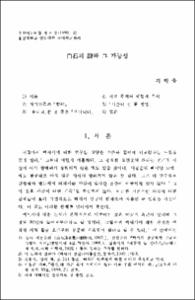2 CASES OF RABBIT SYNDROME
- Abstract
- The application of neuroleptics to schizophrenic and other psychotic patients in the early 1950's led to the therapeutic revolution into the psychiatry, on the other hand neuroleptic-related adverse effects did frequently occur.
The authors experienced 2 cases of rabbit syndrome producing by rare complication of neuroleptic medication.
Two cases were examined for the rabbit syndrome by the description of Villeneuve(1972) and Sovner and DiMascio(1977). The reciprocal coordination test and the finger-tapping technique to worsen the symptoms also were applied to two patients.
The authors emphasized two issues of rabbit syndrome as follows.
First, though the literature search showed that the majority of patients presented with rabbit syndrome which is usually seen after a prolonged exposure to neuroleptic medication with the more potency in the middle or elderly aged are over 45 years old, we suggest that this syndrome might be linked to the younger age factor and the low potency thioridazine in our patient.
Second, the rabbit syndrome is in the importance of the clinical practice because of being readily reversible with antiparkinsonian agents or anticholinergic drugs.
In addition, recognizing this condition and differentiating it from tardive dyskinesia helps in the choice of the proper treatment of orofacial disorders following neuroleptic medication for the long time.
The application of neuroleptics to schizophrenic and other psychotic patients in the early 1950's led to the therapeutic revolution into the psychiatry, on the other hand neuroleptic-related adverse effects did frequently occur.
The authors experienced 2 cases of rabbit syndrome producing by rare complication of neuroleptic medication.
Two cases were examined for the rabbit syndrome by the description of Villeneuve(1972) and Sovner and DiMascio(1977). The reciprocal coordination test and the finger-tapping technique to worsen the symptoms also were applied to two patients.
The authors emphasized two issues of rabbit syndrome as follows.
First, though the literature search showed that the majority of patients presented with rabbit syndrome which is usually seen after a prolonged exposure to neuroleptic medication with the more potency in the middle or elderly aged are over 45 years old, we suggest that this syndrome might be linked to the younger age factor and the low potency thioridazine in our patient.
Second, the rabbit syndrome is in the importance of the clinical practice because of being readily reversible with antiparkinsonian agents or anticholinergic drugs.
In addition, recognizing this condition and differentiating it from tardive dyskinesia helps in the choice of the proper treatment of orofacial disorders following neuroleptic medication for the long time.
- Issued Date
- 1994
- Type
- Research Laboratory
- Alternative Author(s)
- Min,Byung-Kun; Lee,Chang-Wha; Ahn,Joon-Ho; Cheon,Du-Wook; Kim,Hun-Soo
- Publisher
- 울산의대학술지
- Language
- kor
- Rights
- 울산대학교 저작물은 저작권에 의해 보호받습니다.
- Citation Volume
- 3
- Citation Number
- 2
- Citation Start Page
- 86
- Citation End Page
- 89
- Appears in Collections:
- Research Laboratory > The ULSAN university medical journal
- 파일 목록
-
-
Download
 000002024181.pdf
기타 데이터 / 1.44 MB / Adobe PDF
000002024181.pdf
기타 데이터 / 1.44 MB / Adobe PDF
-
Items in Repository are protected by copyright, with all rights reserved, unless otherwise indicated.